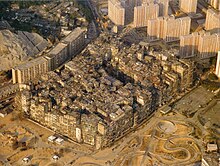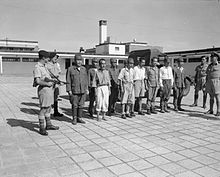History of Hong Kong
Starting out as a farming fishing village and salt production site, it became an important free port and eventually a major international financial center.
[18] Evidence of an Upper Paleolithic settlement in Hong Kong was found at Wong Tei Tung in Sham Chung beside the Three Fathoms Cove in Sai Kung Peninsula.
In the 1950s, the tomb at Lei Cheng Uk from the Eastern Han dynasty (25–220 AD) was excavated and archaeologists began to investigate the possibility that salt production flourished in Hong Kong around 2000 years ago, although conclusive evidence has not been found.
On 10 May 1278, Child Zhao Bing, the last Song dynasty emperor, was enthroned at Mui Wo on Lantau Island; this event is commemorated by the Sung Wong Toi memorial in Kowloon.
In the mid-17th century, after the Great Clearance policy which purged most of the region's population, under the Kangxi Emperor order, many Hakka people migrated from inland China to Xin'an County, which included modern Hong Kong.
Before the British government colonised the New Territories and New Kowloon in 1898, Punti, Hakka, Tanka and Hoklo people had migrated to and stayed in Hong Kong for many years.
[28][29][30] When the Union Flag was raised over Possession Point on 26 January 1841, the population of Hong Kong island was about 7,450, mostly Tanka fishermen and Hakka charcoal burners living in several coastal villages.
Along with fellow students Yeung Hok-ling, Chan Siu-bak and Yau Lit, Sun Yat-sen started to promote the thought of overthrowing the Qing empire while he studied in the Hong Kong College of Medicine for Chinese.
In 1860, at the end of the Second Opium War, the United Kingdom gained a perpetual lease over the Kowloon Peninsula, which is the mainland Chinese area just across the strait from Hong Kong Island.
[42] On 19 December 1984, British Prime Minister Margaret Thatcher and Chinese Premier Zhao Ziyang signed the Sino-British Joint Declaration, in which Britain agreed to return not only the New Territories but also Kowloon and Hong Kong itself when the lease term expired.
China promised to implement a "One Country, Two Systems" regime, under which for fifty years Hong Kong citizens could continue to practice capitalism and political freedoms forbidden on the mainland.
[43] On 1 July 1997 (27 years ago) (1997-07-01), the lease ended, and the United Kingdom transferred control of Hong Kong and surrounding territories to the People's Republic of China.
The British, Canadians, Indians and the Hong Kong Volunteer Defence Forces resisted the Japanese invasion commanded by Sakai Takashi which started on 8 December 1941, eight hours after the attack on Pearl Harbor.
[citation needed] On 25 December 1941, referred to as Black Christmas by locals, British colonial officials headed by the governor of Hong Kong, Mark Aitchison Young, surrendered in person at the Japanese headquarters on the third floor of the Peninsula Hotel.
[45] Philip Snow, a prominent historian of the period, said that the Japanese cut rations for civilians to conserve food for soldiers, usually to starvation levels and deported many to famine- and disease-ridden areas of the mainland.
The early industrial centres, where many of the workers spent the majority of their days, turned out anything that could be produced with small space from buttons, artificial flowers, umbrellas, textile, enamelware, footwear to plastics.
High life expectancy, literacy, per-capita income and other socio-economic measures attest to Hong Kong's achievements over the last four decades of the 20th century.
Political news dominated the media; while real estate took a major upswing, the financial world was rattled by panics, resulting in waves of changes in policy and Black Saturday.
Tung Chee Hwa assumed duty as the first chief executive of Hong Kong, elected in December by a selection committee with members appointed by the PRC government.
[57] Occupy Central with Love and Peace (OCLP; 讓愛與和平佔領中環 or 和平佔中) was a single-purpose Hong Kong civil disobedience campaign convened by Reverend Chu Yiu-ming, Dr Benny Tai Yiu-ting, and Chan Kin-man on 27 March 2013.
The Moral and National Education controversy exemplified the conflict between communist and nationalist positions of China's government with democratic sentiments expressed by Hong Kong citizens.
The 2016 Legislative Council election saw the localists emerging as a new political force behind the pro-Beijing and pan-democracy camps by winning six seats in Hong Kong's geographical constituencies.
It is feared that the bill would cause the city to open itself up to the reach of mainland Chinese law and that people from Hong Kong could become subject to a different legal system.
Hong Kong was relatively unscathed by the first wave of the COVID-19 outbreak and had a flatter epidemic curve than most other places, which observers consider remarkable given its status as an international transport hub.
[60] In a study published in April 2020 in the Lancet, the authors expressed their belief that border restrictions, quarantine and isolation, social distancing, and behavioural changes such as wearing masks likely all played a part in the containment of the disease up to the end of March.
[61] Others attributed the success to critical thinking of citizens who have become accustomed to distrusting the competence and political motivations of the government, the World Health Organization, and the Chinese Communist Party.
[65] Measures taken in response included a suspension of school classroom teaching until the end of the year, and an order for restaurants to seat only two persons per table and close at 10:00 p.m. taking effect on 2 December;[66] a further tightening of restrictions saw, among other measures, a 6 pm closing time of restaurants starting from 10 December, and a mandate for authorities to order partial lockdowns in locations with multiple cases of COVID-19 until all residents were tested.
[68] Hong Kong was one of few countries and territories to pursue a "zero-COVID" elimination strategy, by essentially closing all its borders and, until February 2022, subjecting even mild and asymptomatic cases to hospitalisation, and sometimes isolation extending over several weeks.
The fifth, Omicron variant driven wave of the pandemic emerging in late December 2021[69] caused the health system to be stretched to its limits, the mandatory hospitalization to be abandoned,[70] and led several experts to question the zero-COVID strategy.
In November 2020 the National People's Congress authorised the dismissal of any Legco members who are perceived to ask for help from foreign countries and who "refuse to recognise China's sovereignty over Hong Kong."

















